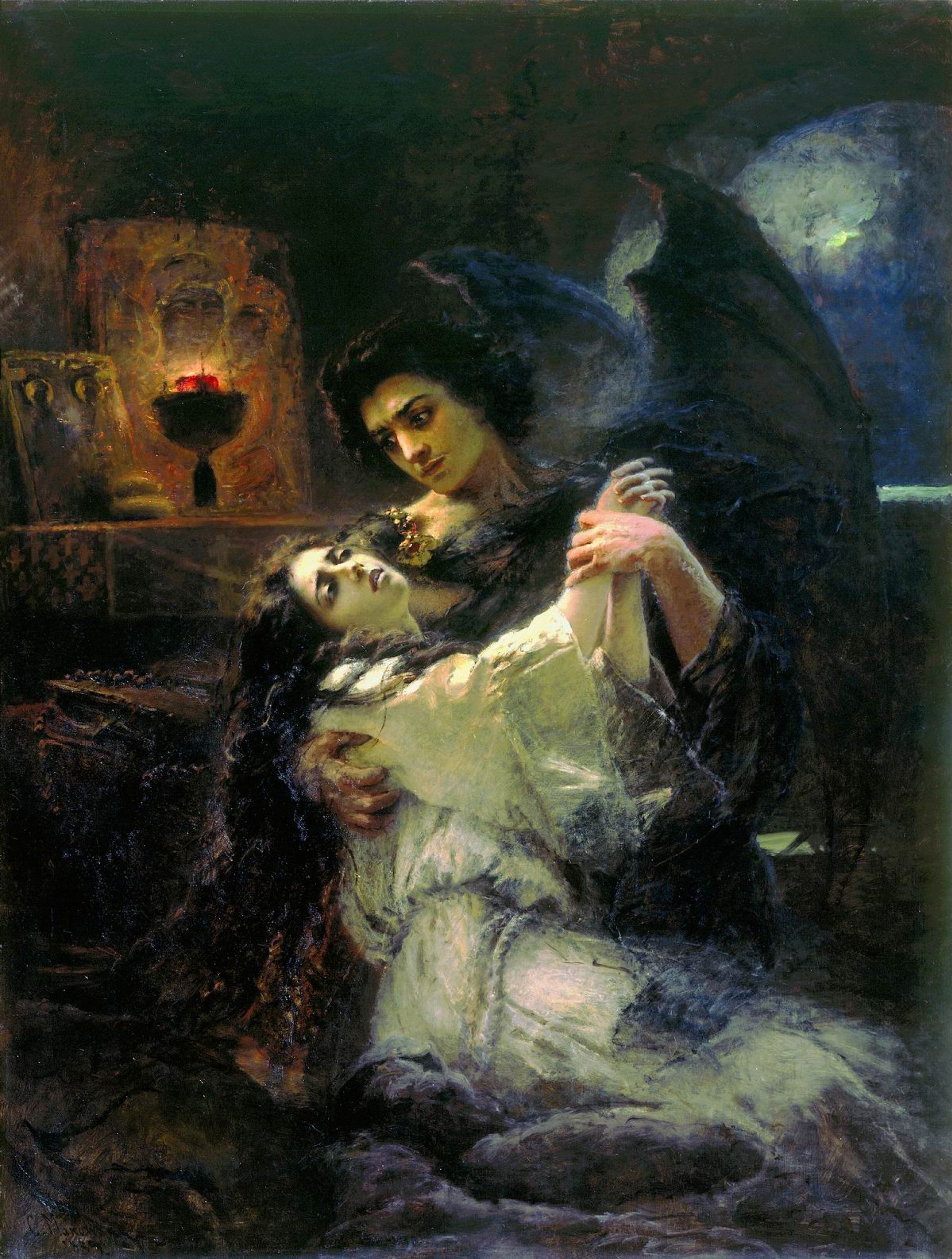Toward the beginning of his career Titian had brought to completion Giorgione's unfinished canvas of Venus asleep in a landscape; some twenty-five years later he adapted the central motif of the recumbent figure to a new setting and transformed its meaning by domesticating that pastoral deity. Giorgione's Venus - withdrawn in a private dream of love that we can share, to a degree, only by an effort of the imagination - has been brought indoors; fully awake now and aware of her audience, she displays her charms in a deliberately public proclamation of love.
Home » Tutti i post

Titian | The Venus of Urbino, 1538 | Uffizi Gallery

Michail Lermontov | Il Demone, 1829 | Seconda parte
Capitolo I
"Padre, padre non minacciarmi più,
la tua Tamara non rimproverare;
vedi che piango, vedi queste lacrime
che già non sono più le prime. Invano
s'affollano, venuti da lontano,
i pretendenti per cercarmi in sposa...
Non sono poche in Gruzia le fanciulle!
Ma io non sarò sposa di nessuno!...
 |
| Mihaly von Zichy (1827-1906) Tamara and Demon |

Berit Hildre, 1964 | Figurative sculptor
Berit Hildre is a self-taught artist, born in Aalesund, in Norway.
For Berit Hildre, the vocation is late, it is born from his meeting with the painter Louis Tresseras with whom she lives today in France.
- "I'm a Norwegian. Twenty years ago, I left my country to travel. I met Louis on Crete. I began to model the earth, just to try. I continued for pleasure" - Bérit
This exceptional sculptor offers us all the innocence of childhood.
Her delicate and graceful little girls and girls embody the state of grace that is childhood, but also its fragility.

Mikhail Lermontov | Demon, 1829 | Chapter I
Demon / Демон is a poem by Mikhail Lermontov, written in several versions in the years 1829-1839.
It is considered a masterpiece of European Romantic poetry.
Lermontov began work on the poem when he was just 14 or 15, but completed it only during his Caucasus exile. Lermontov wrote six major variations of the poem, and the final version was not published until 1842, after his death.
The poem is set in Lermontov's beloved Caucasus Mountains. It opens with the eponymous protagonist wandering the earth, hopeless and troubled. He dwells in infinite isolation, his immortality and unlimited power a worthless burden. Then he spies the beautiful Georgian Princess Tamara, dancing for her wedding, and in the desert of his soul wells an indescribable emotion.
The Demon, acting as a brutal and powerful tyrant, destroys his rival: at his instigation, robbers come to despoil the wedding and kill Tamara's betrothed. The Demon courts Tamara, and Tamara knows fear, yet in him she sees not a demon nor an angel but a tortured soul.
Eventually she yields to his embrace, but his kiss is fatal.
And though she is taken to Heaven, the Demon is left again "Alone in all the universe, Abandoned, without love or hope!..."
 |
| Tamara and the Demon | Konstantin Makovsky, 1889 |

Salvatore Quasimodo | Lament for the South / Lamento per il Sud
La luna rossa, il vento, il tuo colore
di donna del Nord, la distesa di neve...
Il mio cuore è ormai su queste praterie,
in queste acque annuvolate dalle nebbie.
Ho dimenticato il mare, la grave
conchiglia soffiata dai pastori siciliani,
le cantilene dei carri lungo le strade
dove il carrubo trema nel fumo delle stoppie,
 |
| Baldassarre Longoni (1876-1956) | Terre dorate d'Italia, Mietitura, 1940 |

Wassily Kandinsky | VII - Painting Theory
Concerning the Spiritual in Art, 1910
Part II: About painting
From the nature of modern harmony, it results that never has there been a time when it was more difficult than it is today to formulate a complete theory, or to lay down a firm artistic basis.
All attempts to do so would have one result, namely, that already cited in the case of Leonardo and his system of little spoons. It would, however, be precipitate to say that there are no basic principles nor firm rules in painting, or that a search for them leads inevitably to academism. Even music has a grammar, which, although modified from time to time, is of continual help and value as a kind of dictionary.

Pablo Neruda | Per tanto amore la mia vita.. / De tanto amor mi vida..
Per tanto amore la mia vita si tinse di viola
e andai di rotta in rotta come gli uccelli ciechi
fino a raggiungere la tua finestra, amica mia:
tu sentisti un rumore di cuore infranto
e lì dalle tenebre mi sollevai al tuo petto,
senz'essere e senza sapere andai alla torre del frumento,
sorsi per vivere tra le tue mani,
mi sollevai dal mare alla tua gioia.
 |
| Leonid Afremov (1955-2019) | Romantic Impressionist painter |

Walt Whitman | Non lasciare che finisca il giorno senza essere cresciuto un po'..
Non lasciare che finisca il giorno senza essere cresciuto un po',
senza essere stato felice, senza avere aumentato i tuoi sogni.
Non lasciarti vincere dallo scoraggiamento.
Non permettere che nessuno ti tolga il diritto ad esprimerti,
che e' quasi un dovere.
Non lasciar cadere la tensione di fare della tua vita
qualcosa di straordinario.
 |
| Jon Bøe Paulsen, 1958 | The Blue Hour |
Iscriviti a:
Commenti (Atom)



